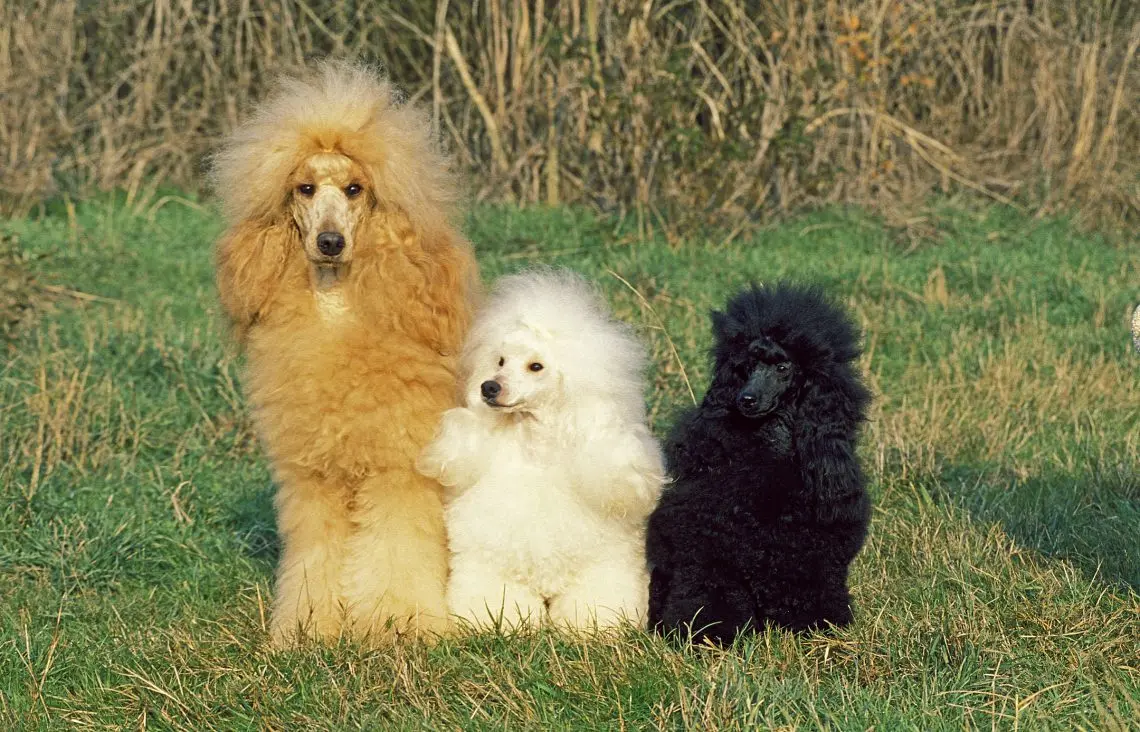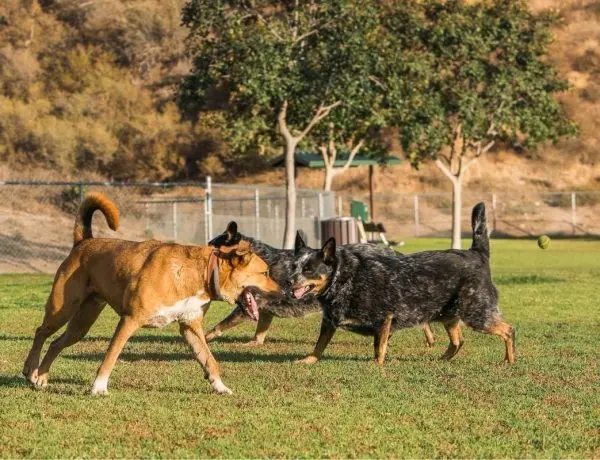Poodles descend from some of the oldest breeds of dog in the world, making them one of humankind’s most ancient companions. As a result of this, Poodles have been under development as a breed for over four hundred years.
What exactly is a Poodle? A Poodle is a German water retriever that comes in three different sizes—standard, miniature, and toy. Standard Poodles serve as hunting and herding dogs, while toys were bred by the aristocracy to serve as house pets. All Poodles have a distinctive wooly coat that can be shaved into a variety of patterns.
While Poodle standards vary somewhat from kennel club to kennel club, a poodle’s general appearance has remained mostly untouched for hundreds of years. Keep reading to learn more about these intelligent dogs and their breed standard.
Table of Contents
Ancestry of the Modern Poodle
The modern Poodle is one of the most distinctive dogs in the world, but this dog has one of the most unclear origins in canine history. Because the types of dogs that Poodles originated from first appeared during the Dark Ages, records pointing to the origins of Poodles and other livestock were often not written down.
Most people don’t think of Poodles as herding dogs. Still, for a majority of their early history, the ancestors of the Poodle were versatile camp followers who traversed medieval Europe as nomads. While these dogs would not be recognizable as the Poodle you know today, dog historians believe that these predecessors form the early lineage of the modern Poodle.
Once the predecessors of the Poodle were exposed to Germany and France, these nomadic dogs were repurposed from herding dogs into hunting dogs. Taking advantage of the Poodle’s exceptionally high intelligence, waterproof coat, and natural desire to please, the aristocrats of Germany and France converted these herding dogs into exceptional water retrievers.
Show Standard of the Poodle
Outside of their size differences, the different classifications of poodles share a similar appearance standard, even between various kennel clubs such as the American Kennel Club (AKC) and the United Kingdom Kennel Club (KC). Some deviations from the breed standard may result in faults in a show or even disqualification.
The following sections discuss some of the qualities that breeders look for in Poodles to determine how closely the Poodle follows the breed standard.
General Appearance
The general appearance of a Poodle is that of a well-muscled, lively, visibly intelligent dog. Although known as hams and goofballs outside of the ring, a Poodle in a show has an air of sophistication and grace as they move around the ring.
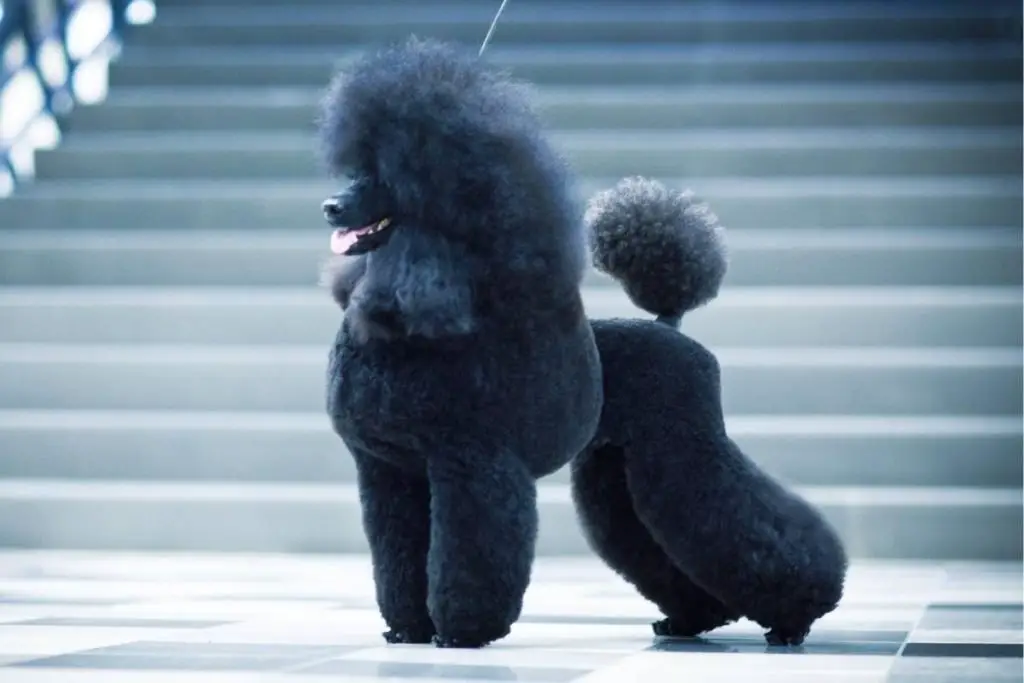
In larger Poodles, the dog is expected to have the gait, appearance, and activity level of any other working dog. While their coat may set them apart from the average retriever or herding dog, a Standard Poodle is still a working dog at heart, and the way they carry themselves should convey that.
Since Standard Poodles are considered working dogs, they aren’t penalized in a show for displaying scars or any other permanent sign on the body or coat of working in the field. Also, any visual and cosmetic faults that are evaluated in the Poodle’s bearing are assessed in how they have the potential to hinder the Poodle’s ability to work as either a hunting or herding animal.
Personality
Poodles should have a friendly air to them, as this breed is known primarily to be affectionate among children. Unfortunately, overbreeding has led to some lines displaying either streaks of shyness (a trait that leads to fear biting and other unwanted behaviors) as well as viciousness. Both of these personality traits are to be strictly avoided in show Poodles and disqualified if displayed.
Head and Expression
Under any standard, Poodles are known for their dark, intelligent eyes that are set far apart enough in the head to give an impression of alertness.
Other “breed standard” requirements of Poodle eye color include:
- Lighter eyes than dark brown are a fault in most coat colors, though liver-colored dogs are permitted to have amber eyes.
- The eyes of the Poodle should neither protrude from their head (giving them a “bug-eyed” look) nor sink in.
- The shape of the eyes should be oval, not round.
Muzzle
The muzzle of a poodle should be sharp and straight, with an elegant chiseled effect underneath the eyes. This is especially noticeable in shaved cuts. The muzzle of the Poodle should be solid with no extra lip. In length, the muzzle should be roughly the same length as the length of the skull itself from the front to the occiput (the base of the skull). Teeth should be white and healthy with a scissor bite.
Ears
The long, floppy ears of a Poodle are one of its most distinguishing features and one of the features they share with other working dogs that do their service in the water. The ears themselves should be long, wide, and covered with a thick feathering of fur. Ears should not be cocked out and instead should lie flat against the head to either side of the eyes.
Groomers need to pay close attention to the hair on a Poodle’s ears, as ear fringe that is too long is considered a show fault and can result in a penalty.
Body
The body of a Poodle should be well-muscled and proportioned to the size of the dog. The neck is relatively long, allowing the Poodle to carry it high, with a sense of pride in its gait. There should be no excess skin around the neck or other areas of the body—all skin should be smooth and taut, giving the impression of a trim athlete.
Poodles possess a level topline with a broad barrel chest and broad loins. The only dip in the dog’s back should be a slight hollow just after the Poodle’s shoulders. Overall, the body should give a sense of athleticism and proficiency.
The elbows and shoulders of the dog should be set squarely beneath the dog’s forequarters, with no splayed feet or elbows. The claws on the feet should be kept short, but not too short for the comfort of the dog.
Differences Between Kennel Club Standards
For more specific breakdowns of the Poodle standards used by the American Kennel Club and the United Kingdom Kennel Club, you can see the standards laid out here:
While there are some minor differences in the standards, the most visible differences in the way that poodles are shown between the American Kennel Club and the United Kingdom Kennel Club is in what types of coats and clips are allowed.
Here is a breakdown of the coat qualifications for show Poodles in the American Kennel Club:
- Only puppies under twelve months can be shown in a puppy clip.
- Dogs twelve months and older must be shown in either an English saddle or Continental clip.
- Stud dogs, brood bitches, and dogs that aren’t in a formal competition can be shown in “sporting” or utility clips (a similar clip to the puppy clip).
- Corded coats are permitted.
In contrast, here is the breakdown of the coat qualifications for show poodles in the United Kingdom Kennel Club:
- Corded coats are permitted.
- Puppy clips, English saddle clips, Continental clips, and Sporting clips are all permitted.
In both kennel clubs, the general phenotypes and standards for the Poodle’s appearance remain mostly unchanged. It is only in the presentation of their unique coat that the rules differ from continent to continent. Even with as many coat colors and patterns as are permitted in both show and the field, Poodles are still one of the most easily recognizable dogs in the world.
Different Sizes of Poodles
A Poodle from America will generally look similar to a Poodle from Asia or England. Still, there is one thing you’re likely to notice no matter where a Poodle is from—they come in a few different sizes. There are three size variations of Poodles that are accepted in dog shows, and each of these sizes served a slightly different function in human society.
These are the three poodle sizes that are currently accepted by the AKC and United Kingdom Kennel Club show standards:
- Standard Poodle: Standard Poodles are the largest of the Poodle sizes, and this is the size of Poodle that is still most often used for utility purposes such as hunting and herding. By the breed standard, a Standard Poodle should stand between twenty-two and twenty-seven inches from the shoulder and weigh approximately forty-five to seventy pounds.
Standard Poodles are also used in other utility work such as police work or search and rescue since their larger size makes them more capable of physical labor.
Miniature Poodle: While Standard Poodles were famous among the aristocracy of medieval Europe, these large athletic dogs were sometimes considered difficult to house indoors, which caused breeders to shrink them down to a more manageable size for the indoors.
Miniature Poodles are bred between ten and fifteen inches high at the shoulder and should ideally weigh between fifteen and seventeen pounds. Miniature Poodles were also bred to hunt truffles for the aristocracy as well as serve as companions.
Toy Poodle: The tiniest type of Poodle is the Toy Poodle, and these dogs continue to be bred almost exclusively as pampered and well-loved house pets. The small size of these dogs makes them very portable in comparison to other breeds, and during the Victorian era, Toy Poodles were cut and dyed according to fad fashion.
- Various attempts have been made by backyard breeders to breed Toy Poodles to even smaller non-standard “teacup” sizes, but breeding Poodles this small often leads to serious health issues such as hypoglycemia and idiopathic epilepsy.
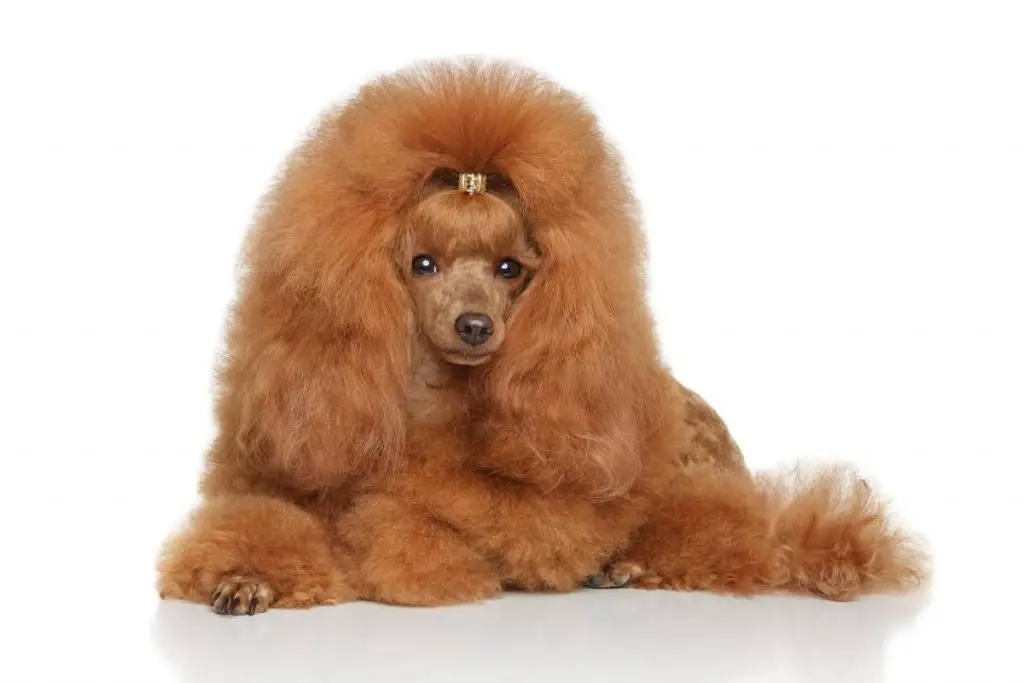
Because the different size varieties of Poodles are used in such different ways by people, the different size classifications of Poodles are judged according to their utility. In the AKC, Miniature and Standard Poodles are placed alongside other companion type dogs in the Non-Sporting Group, while Toy Poodles are shown in the Toy Group.
The Poodle’s Coat and Its Cut
While many pet Poodles sport a utility cut that makes them look like a fuzzier version of any other water dog, show Poodles have their coats cut in a wide array of patterns. All types of Poodles, no matter what size or bloodline, possess the same wooly coat, but once they are groomed for show, many of them can look drastically different.
There are advantages to cutting a Poodle’s coat in different ways. A Poodle who acts primarily as a companion in the household or as a working dog will be more comfortable (and stay looking better) in a utility cut or puppy cut. But in a show, specialty clips are designed to show off the lines of the dog to their fullest advantage.
These are the most popular Poodle cuts:
Puppy Cut
A puppy cut is a type of haircut used on Poodles (and some other fine-coated dogs) that have no intention of being shown and are only household pets. Puppy cuts are used on house pets because they are easy to maintain compared to show cuts and—especially with smaller Poodles—a puppy cut allows the dog to keep a youthful appearance long after puppyhood has ended.
Puppy cuts are also popular on working dogs since they can be performed as easily by laymen and ranchers as they can by professional dog groomers. Most puppy cuts involve simply scissoring and shaving the dog’s hair relatively short all over its body, without any kind of shaved flair.
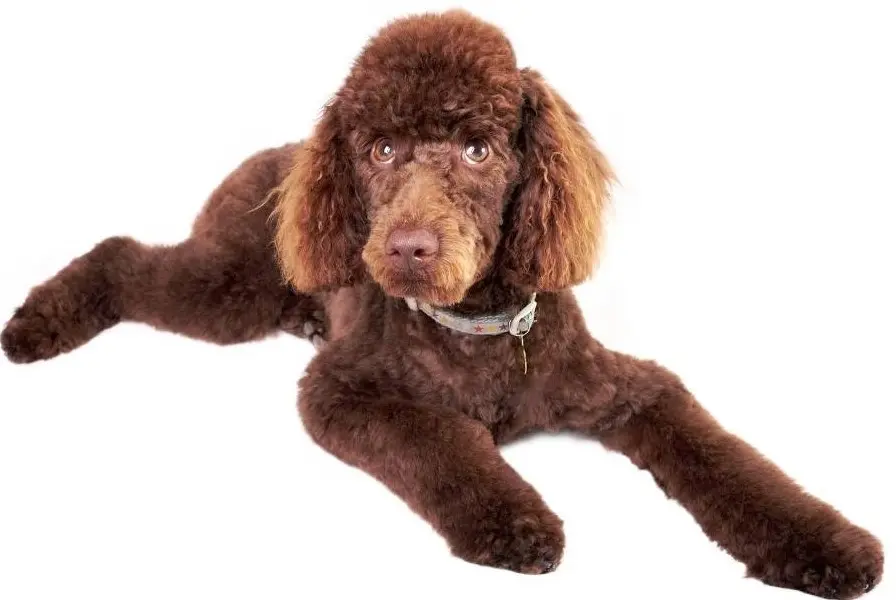
Working and household Poodles need to be groomed approximately every six weeks, a relatively large amount of grooming compared to other breeds. But it’s even more extreme for show dogs who may need maintenance cuts and grooming every three weeks between shows to keep their coat in proper order for the ring.
Utility and puppy cuts are an excellent choice for pet Poodles since they don’t require a lot of extra maintenance to keep looking good. They give the Poodle a somewhat softer and cuddlier appearance that is more suitable for a household pet.
Continental Clip
The continental clip is a type of Poodle haircut that Poodles are best known for since it gives them an appearance unique among show dogs. This haircut shaves the dog down to the skin in several areas of the body other than the saddle (across the dog’s withers), the chest area, the head, and the tail. Even though this grooming style is associated with high-end shows, they originated in the working history of the Poodle breed.
While the patches of fur left on a Poodle after being shaved down for a specialty cut may look odd, they were developed for a specific purpose. They help to keep dogs warm in frigid waters as they dove into lakes and ponds after fallen waterfowl while reducing the amount of debris caught in the fur and leaving them sleek enough to move quickly.
English Saddle Clip
English saddle clips look very much like continental clips if you aren’t well-versed in how Poodles are cut for a show. The main difference is that, in the English saddle clip, the Poodle’s face and tail are shaved as well as the rest of its body, and pompoms of fur are left as “bracelets” around the dog’s ankles.
Sporting Clip
A sporting clip is similar to a puppy cut except that it involves shaving the face, feet, throat, and the base of the tail. A pompom is left on the dog’s tail for a cosmetic effect. The rest of the dog’s coat is trimmed down to roughly an inch in length, though some extra length is allowed in the legs for aesthetics. A sporting clip is popularly used in hunting and herding dogs who also perform in shows.

Corded Coats
Although not as popular as other clips, Poodles are allowed to be shown with a corded coat—that is, a coat that has been allowed to grow long and become matted into natural dreadlocks. These dreadlocks have to be carefully maintained to prevent them from becoming matted and hurting the dog by pulling on their delicate skin.
Other Specialty Cuts
Other non-official cuts are given to Poodles outside of the show ring, such as country cuts or bikini cuts, but these cuts are just variations on the official show cuts that are given to house dogs for cosmetic purposes. These cuts are not allowed at show and can result in disqualification. The rules for which cuts are and aren’t allowed at show differ from kennel club to kennel club.
While grooming a Poodle isn’t difficult once you’ve learned how to do it, have trained the dog to tolerate it well, and have all the tools available to perform the grooming, it is more time and labor-intensive than most other breeds. But many Poodle owners consider it a labor of love!
What Colors Do Poodles Come In?
Poodles come in a wide variety of coat colors, which makes them different from most other breeds of dog, which are only limited to a few. While not all colors of Poodle are accepted in the show ring as official coat colors, most of them are wildly popular in household Poodles, and there are new combinations of coat color being bred into the Poodle family all the time.
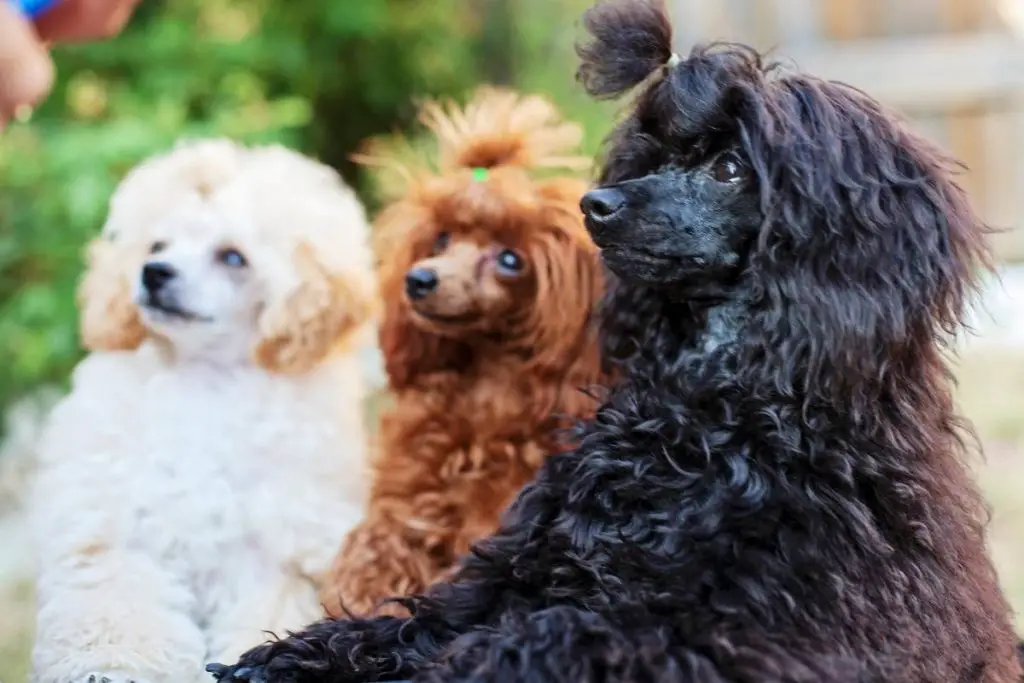
These are a few of the many colors that Poodles can be found in:
- White
- Silver
- Gray
- Cream
- Blue
- Chocolate
- Black
- Phantom (a pointed coat color similar to a Doberman or Rottweiler)
- Café au Lait
- Apricot
- Red
- Liver
- Parti-colored (two-toned)
Some specialty coat colors in Poodles are challenging to find, especially in Miniature Poodles, which means some Poodle puppies can go for upwards of several thousand dollars if they possess a unique colored coat. Unfortunately, because they come in so many colors, Poodles are also popular for crossing with other small and large dog breeds to create “designer” dogs.
Poodles and Training
Poodles are among the easiest dogs in the world to train due to their people-pleasing nature, their natural comedic personalities, and their sharp intelligence. Because of this, Poodles have been entertainers and workers alongside humans for hundreds of years.
Here are some of the roles that Poodles have been trained into other than herding and hunting:
The circus: A clown’s best friend, Poodles have always been one of the most popular dogs used in circus stunts and acts because of their high agility and trainability. Whether jumping through flaming hoops or balancing on a ball, Poodles in the circus can be trained to do just about anything to get a laugh from the audience.
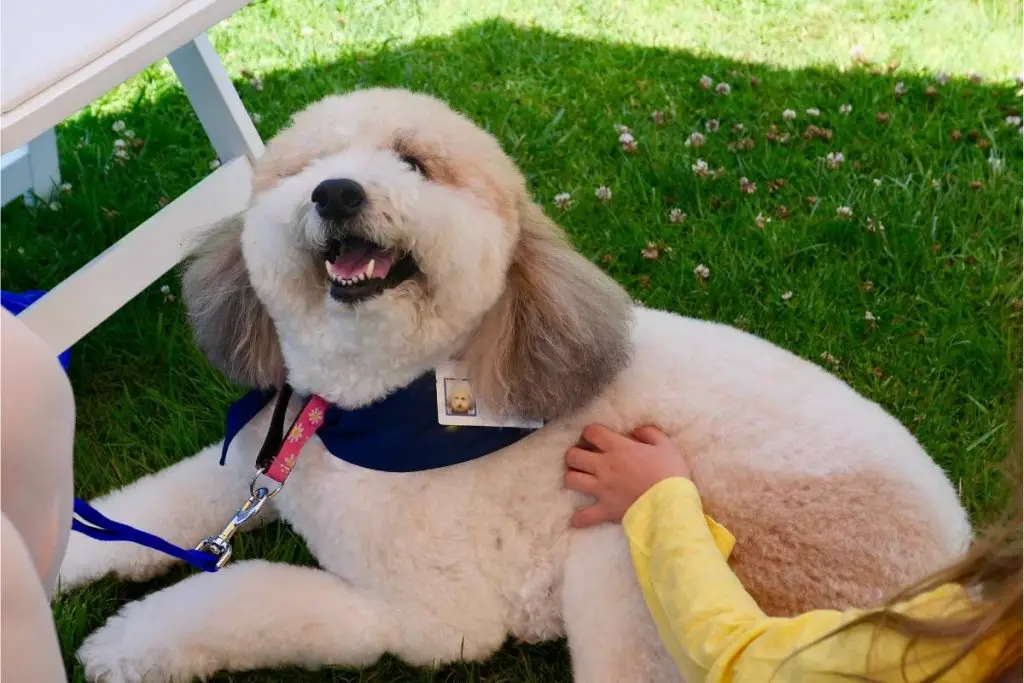
Therapy work: Poodles are becoming increasingly popular therapy dogs because of their attractive wooly coats and friendly attitudes towards people, especially children. This makes them welcome guests in hospital wards and nursing homes across the globe.
War dogs: While they were beat out by a few other breeds as frontline infantry dogs during the World Wars, Poodles nevertheless saw strong popularity in Germany and elsewhere as both scouting dogs and guards of military installations. Their high intelligence meant that they could be trained for a wide variety of tasks, from message delivery to surveillance.
Because they love people as a general rule if properly socialized, come in so many sizes, and are easy to train if the effort is made, Poodles can be easily molded into many complementary roles in human work and culture.
Purebred Poodle Health
Poodles are a generally healthy breed that is long-lived—especially the smaller varieties—but, unfortunately, years of line breeding have caused certain congenital diseases and defects to be passed down throughout several bloodlines of these dogs, both in America and in Europe.
Here are some of the health problems that are commonly found in the Poodle breed:
Hip Dysplasia: Like many working breeds, Standard Poodles are at risk for hip dysplasia. This disorder causes the hip joints to progressively move out of alignment, leading to both pain and mobility issues in the hind legs. Hip dysplasia is increasingly checked against by more reputable breeders to try to eradicate it from breeding lines.
Epilepsy: Epilepsy (both related to hypoglycemia issues and idiopathic epilepsy) can be found in Poodles, though, for the most part, this disorder is controllable through medication. Epileptic seizures trigger by hypoglycemia can become a problem in especially small Poodles, such as teacup varieties. More and more breeders are participating in studies to track the prevalence of epilepsy in the breed.
Progressive retinal atrophy: Progressive retinal atrophy is a form of congenital blindness that affects Poodles as they grow older, eventually leading to senior dogs will little to no sight left at all. Progressive retinal atrophy usually presents earliest as loss of night vision, eventually devolving into total blindness.
Addison’s disease: Addison’s disease is one of the more serious (if rare) medical conditions that can affect Poodles and is an autoimmune disease that can cause the adrenal glands to begin attacking themselves. Also known as primary hypoadrenocorticism, Addison’s disease has a wide variety of symptoms and is frequently misdiagnosed as other disorders such as liver disease or kidney failure.
Bloat: Bloat is an affliction that tends to affect larger dogs when they swallow too much air while eating, causing the stomach and intestines to contort and occasionally flip over. This can restrict blood flow to the digestive system, causing severe pain and death of the internal organs. Bloat is a serious illness but can be prevented in large dogs by not allowing them to eat or drink too quickly and by lifting their food off the ground in an elevated feeder.
Hypoglycemia: Hypoglycemia is a condition that is prevalent in miniature and toy breeds, especially when dogs are young and haven’t yet developed the ability to regulate their blood sugar properly. Hypoglycemic shock caused by low blood sugar between meals can cause a dog to go into a coma or trigger epileptic fits. To prevent hypoglycemia, small puppies should be fed frequently throughout the day to prevent drops in blood sugar.
It may seem like Poodles have a lot of medical issues when they’re all laid out in a row, but the majority of Poodles that come from reputable breeders enjoy decades of good health with proper nutrition and exercise. However, it’s essential to know what kind of problems may potentially crop up in a Poodle due to congenital issues so that early symptoms of these problems can be detected and corrected as quickly as possible.
Ensuring that you obtain a Poodle from a breeder who does genetic checks for prevailing congenital diseases in the breed can go a long way towards ensuring that you don’t end up with a dog that has severe medical issues down the road.
Poodles Are a Fascinating Breed
Associated with high society but descended from working stiffs, Poodles are one of the oldest breeds in the history of purebred dogs. With an intelligence rivaling that of the Border Collie and a sensibility that allows them to perform expected tasks without being commanded to do so, it’s easy to see why Poodles are the star of both the field and the show ring.

